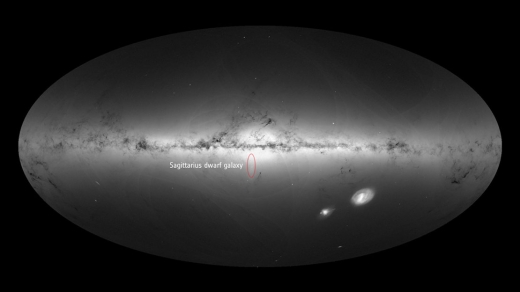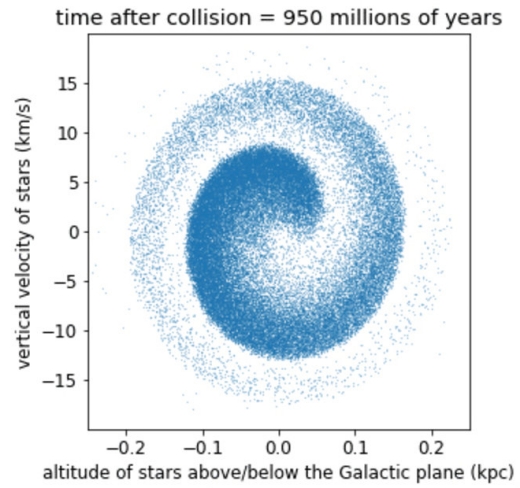The Sagittarius Dwarf Galaxy is a satellite of the Milky Way, about 70,000 light years from Earth and in a trajectory that has it currently passing over the Milky Way’s galactic poles; i.e., perpendicular to the galactic plane. What’s intriguing about this satellite is that its path takes it through the plane of our galaxy multiple times in the past, a passage whose effects may still be traceable today. A team of scientists led by Teresa Antoja (Universitat de Barcelona) is now using Gaia data to trace evidence of its effects between 300 and 900 million years ago.

Image: The Sagittarius dwarf galaxy, a small satellite of the Milky Way that is leaving a stream of stars behind as an effect of our Galaxy’s gravitational tug, is visible as an elongated feature below the Galactic centre and pointing in the downwards direction in the all-sky map of the density of stars observed by ESA’s Gaia mission between July 2014 to May 2016. Credit: ESA/Gaia/DPAC.
This story gets my attention because of my interest in the Gaia data and the uses to which they can be put. We just looked at interstellar interloper ‘Oumuamua and saw preliminary work on tracing it back to a parent star. No origin could be determined, but the selection of early candidates was an indication of an evolving method in using the Gaia dataset, which will expand again with the 2021 release. The Sagittarius Dwarf galaxy compels a different method, and we’ll be seeing quite a few new investigations with methods of their own growing out of this attempt to begin a three-dimensional map of the Milky Way. A kinematic census of over one billion stars will come out of Gaia.
A billion stars represents less than 1 percent of the galactic population, so you can see how far we have to go, but we’re already finding innovative ways to put the Gaia data to use, as witness Antoja’s new paper in Nature. As we saw in ‘Oumuamua’s Origin: A Work in Progress, Gaia uses astrometric methods to measure not just the position but the velocity of stars on the plane of the sky. We also get a subset of a few million stars for which the mission will include radial velocity, producing stellar motion in a three-dimensional ‘phase space.’
From the Antoja paper:
By exploring the phase space of more than 6 million stars (positions and velocities) in the disk of the Galaxy in the first kiloparsecs around the Sun from the Gaia Data Release 2 (DR2, see Methods), we find that certain phase space projections show plenty of substructures that are new and that had not been predicted by existing models. These have remained blurred until now due to the limitations on the number of stars and the precision of the previously available datasets.
Antoja’s team found that these unique data revealed an unexpected pattern when stellar positions were plotted against velocity. The pattern is a snail shell shape that emerges when plotting the stars’ altitude above or below the plane of the galaxy against their velocity in the same direction. Nothing like this had been noted before, nor could it have been without Gaia.
“At the beginning the features were very weird to us,” says Antoja. “I was a bit shocked and I thought there could be a problem with the data because the shapes are so clear. It looks like suddenly you have put the right glasses on and you see all the things that were not possible to see before.”

Image: This graph shows the altitude of stars in our Galaxy above or below the plane of the Milky Way against their velocity in the same direction, based on a simulation of a near collision that set millions of stars moving like ripples on a pond. The snail shell-like shape of the pattern reproduces a feature that was first seen in the movement of stars in the Milky Way disc using data from the second release of ESA’s Gaia mission, and interpreted as an imprint of a galactic encounter. Credit: T. Antoja et al. 2018.
Stellar motions, we are learning, produce ripples that may no longer show up in the stars’ visible distribution, but do emerge when their velocities are taken into consideration. Antoja and colleagues believe the cause of this motion was the Sagittarius Dwarf Galaxy, whose last close pass would have perturbed many stars in the Milky Way. The timing is the crux, for estimates of when the snail shell pattern began fit with the timing of the last dwarf galaxy pass.
As with the ‘Oumuamua study, we’re at the beginning of teasing out newly available information from the trove that Gaia is giving us. To firm up the connection with the Sagittarius Dwarf Galaxy, Antoja team has much to do as it moves beyond early computer modeling and analysis, but the evidence for perturbation, whatever the source, is clear. From the paper:
…an ensemble of stars will stretch out in phase space, with the range of frequencies causing a spiral shape in this projection. The detailed time evolution of stars in this toy model is described in Methods and shown in Extended Data Fig. 3. As time goes by, the spiral gets more tightly wound, and eventually, this process of phase mixing leads to a spiral that is so wound that the coarse-grained distribution appears to be smooth. The clarity of the spiral shape in the Z-VZ [vertical position and velocity] plane revealed by the Gaia DR2 data, implies that this time has not yet arrived and thus provides unique evidence that phase mixing is currently taking place in the disk of the Galaxy.
The shell-like pattern thus contains information about the distribution of matter in the Milky Way and the nature of stellar encounters. The bigger picture is that untangling the evolution of the galaxy and explaining its structure is what Gaia was designed for, a process that is now gathering momentum. We’re only beginning to see what options this mission is opening up.
The paper is Antoja et al., “A Dynamically Young and Perturbed Milky Way Disk,” Nature 561 (2018), 360-362 (abstract / preprint).



2021 release
Will this be early, middle or late 2021?
I am having a lot of difficulty wrapping my head around what exactly we are seeing. I think an animation of the perturbations caused by the satellite galaxy as it passes through our galaxy would help in visualizing this.
The spiral graph shows stars spreading out from the galactic plane upwards and downwards losing velocity the further they spread from the galactic plane.
The darkest region is the oldest and slowest stars, as at the base of a corkscrew: the dark ones at the top are in the galactic plane (fast; away from the galactic plane upwards), at the base of the corkscrew. The dark ones on the left side are further from the galactic plane (slow) and below it. The less dark ones at the bottom are in the galactic plane (faster; away from the galactic plane downwards). The less dark ones on the right are further from the galactic plane (slow) and above it.
The lighter ones are similarly disposed, with the lightest ones at the tip of the corkscrew. The corkscrew may be a flattened cone rather than a cylinder.
The model is about phase mixing, which I interpret as an oscillation that slowly returns to equilibrium as interactions between the stars at different phases of the oscillation reduce the amplitude and cohesiveness of the stars in a particular phase of the oscillation.
In my head I see the satellite galaxy pass through the galactic plane, gravitationally dragging the stars with it. After the satellite passes through, the stars dragged out of the plane are then attracted back towards the plane and this results in an oscillation. As the stars continue to oscillate, their continual interaction with the stars in the plane damp the oscillations so that over time, the amplitude (and hence maximal velocity) is damped, phase shifts occur, until the oscillations disappear. The authors’ equations describe the dynamics.
Is that a reasonable simple model of what is happening, or am I missing something important?
A bit offtopic but interesting:
There appear to be two conferences happening now by Nasa that are very fascinating:
One is about technosignatures
https://www.hou.usra.edu/meetings/technosignatures2018/
The other is about NIAC
https://www.nasa.gov/content/niac-symposium
and includes such amazing topic as bubble telescopes proposal ( KST Kilometre Space Telescope)
https://www.nextbigfuture.com/2018/09/giant-one-kilometer-space-bubble-telescopes.html
A quite innovative idea that received funding already, I confess never hearing about it before, but it seems it has been worked on for some time.
Would love to see both conferenced covered.
I have a report on the technosignature conference in the pipeline, though not a firm date yet. Wish I could have been there for that one myself.
Considering the trouble that NASA has had with the James Webb Space Telescope – it was supposed to launch this year, but that date has been pushed out to 2021, with the resulting extra funding required – I have to wonder when or if we will ever see even larger space telescopes any time soon, at least by this space agency.
They need a real space infrastructure already set up if they want to put big structures in space. If something goes wrong with the JWST while in its high Earth orbit, there is essentially no way to fix it, unlike with HST in LEO and was designed to be repaired and upgraded by astronauts in space. There are so many steps and procedures that JWST has to go automatically through in order to function properly, almost any one of them could be a mission ender if they fail.
GAIA finds some hypervelocity stars headed towards the Milky Way galaxy from the great beyond…
https://www.universiteitleiden.nl/en/news/2018/10/gaia-spots-stars-flying-between-galaxies